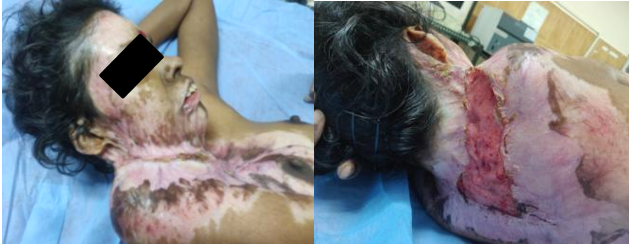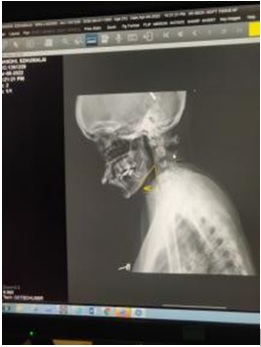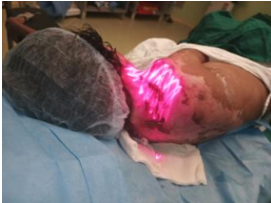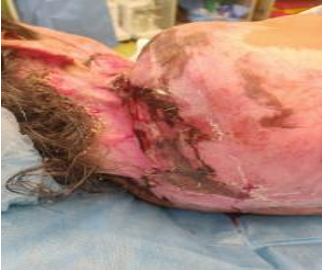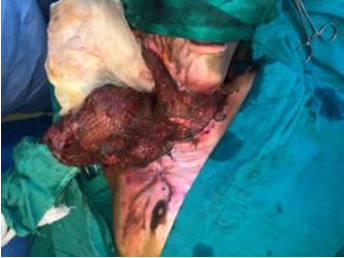Introduction
Unfortunately, the head and neck area remains the most frequently affected anatomic area involved in burn injuries.1 The resulting disfigurement because of scarring, and especially the often-developing contractures, may severely limit the patients functional and social rehabilitation.2 As such, the ultimate goals of post burn reconstruction have virtually remained unchanged in that the ideal reconstruction, includes aggressive and complete release of all contractures and replacement with tissue of matching quality compared with the remaining face and surrounding areas. Although doing so, adhering to the principles of reconstructing the facial subunits should always be considered.3 especially, the neck with its propensity to develop severe contractures and its aesthetic importance, deserves utmost attention.4 Skin grafts remain a valuable weapon in the reconstructive surgeon’s armory, for example, in addressing post burn contractures or defects on the face, neck, and dorsum of the feet. Full thickness skin grafts (FTSGs) are favored over split-thickness grafts principally due to lower recurrent contracture rates and better color match.5 However; achieving good graft take in large defects is difficult, particularly when the surface is not flat, such as on the neck or cheek. Graft loss leads to recurrent contracture formation, in addition to pigmentary disturbances. Survival of a skin graft on its recipient site relies not only on a clean and well-vascularized bed but also on adequate immobilization with no infection, hematoma, or serous collection beneath the graft. In this study we are sharing our experience of post burn neck contracture associated with non-healing ulcer in which first skin grafting was done for ulcer & then release of contracture & skin grafting was done.
Materials and Methods
This study was conducted in the Department of Plastic Surgery in a tertiary care institute. Informed consent was obtained from the patient under study. Department scientific committee approval was obtained. It is a single center, non-randomized, non-controlled study. The patient under study was a 40-year old female (Figure 1) with no other known comorbidities. Patient was analyzed systematically and was found to have a post burn contracture involving the right side of the neck. The neck contracture was associated with infected raw areas. On x-ray, her cervico-mental angle on presentation was 46 degrees (Figure 2). For non-heaing ulcer bed was prepared by controlling infection with local antimicrobials & antibiotics according to culture sensitivity and non-viable necrotic tissue was surgically debrided followed by regenerative technology using low level laser therapy (Figure 3). Once wound bed was ready, skin graft was applied (Figure 4). Subsequently contracture was released and split thickness skin grafting was done (Figure 5). No complications were noticed in the post operative period. Patient was discharged & being followed up every monthly.
Results
Split thickness skin graft took up well both at non-healing ulcr and contracture released site (Figure 5, Figure 6). No complications were noticed in the post operative period. Patient was discharged & being followed up every monthly.
Discussion
Achieving good functional and aesthetic outcomes when treating severe post burn head and neck contractures, remains a challenging task. Simple release of contractures followed by large area skin-grafting can be considered. Full thickness skin grafts (FTSGs) are favored over split-thickness grafts principally due to lower recurrent contracture rates and better color match.5 However, achieving good graft take in large defects is difficult, particularly when the surface is not flat, such as on the neck or cheek. Graft loss leads to recurrent contracture formation, in addition to pigmentary disturbances. Survival of a skin graft on its recipient site relies not only on a clean and well-vascularized bed but also on adequate immobilization with no infection, hematoma, or serous collection beneath the graft. Split thickness skin graft is versatile and can survive on areas where FTSGs cannot, especially on areas of high mobility such as the head and neck. The advantages of FTSGs over split thickness grafts have been well described.6 FTSGs result in soft, pliable skin with minimal contraction, as well as allowing mobility over joints and animated areas.7 and they are also more functional, allowing hair growth, sweat, and sebaceous secretions and sensation. The texture, contour, and pliability result in a more favorable cosmetic appearance. However, FTSGs have been advocated with caution to resurface large defects as take rates are not as reliable as split thickness skin grafts.8 Irregular takes results in recurrent contractures, patchy pigmentation, and poor cosmetic appearance.


